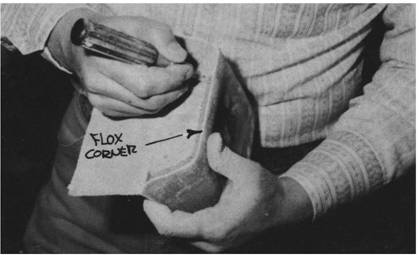Q2 Plans Chapter 3 Page 3-22
- Details
- Category: Q-2/Q-200 Plans
- Published: Sunday, 28 May 2006 03:05
- Written by Quickie Aircraft Corporation
- Hits: 5031
|
.....Mix Safe-T-Pox,
make a small batch of slurry,and save the remaining epoxy. Slurry the
foam surface and apply two plies of BID to the contoured surface. Start
the layup in the center and work out toward the edges. If you have
trouble getting the glass into the depression corners without bubbles,
lift the plies and wipe in a little dry micro. You will then find that
it will lay smoothly in without voids (see sketch). This depression
is sharper than any in your airplane and is intended to give you a
feeling of how sharply you can form the cloth.

.....Before laying
the third BID ply down, place your favorite photo in the depression,
and
then lay the third BID ply over it. Scissor trim the excess glass cloth.
Allow to cure and knife trim the edges. The lower edge is trimmed flush
with the bottom of the foam block.

.....Wait until
the second layup is fully cured. Remove the 1 inch foam block with
a butcher
knife
and sanding block. Remove foam for a 1/4" flox corner and sand
the glass surface dull.
 
.....Mix Safe-T-Pox,
a small batch of flox, and a small batch of micro slurry. Fill the
corner with flox and slurry the foam. Lay up the four UNI plies with
the orientation shown.
 
.....Knife trim the
edges. After 12-hour cure, sand the edges with 100-grit sandpaper as
required
for smoothness.and good appearance.

.....It may at this
time seem a bit ridiculous to use three layups, about four hours work,
and
two days cure, just to make a book end! But remember, this book end
was not designed for ease of construction; it was designed instead,
to let you get a first hand exposure to the following operations before
starting on your airplane; glass cutting, foam preparation (slurry),
BID and UNI layups, flat surfaces, corners, and compound curves, flox
corner, knife trim, concave and convex foam carving, glass to glass
surface preparation, and sanding edges. So, use this experience to
your best benefit and spend the curing time studying the plans. Even
if you're experienced in glass layups, the book end is a worthwile
project to get familiar with the workability of this BID and UNI weave
cloth
|
||||
PAGE 3-22 |
||||



